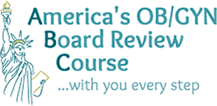Practice Test
PRACTICE TEST QUESTIONS & ANSWERS - Order your manuals now
1) Female Pelvic Medicine: A 33-year-old multigravida patient presents complaining of dyspareunia and “feeling loose” during intercourse. Obstetrical history includes that of an episiotomy with a 4th-degree extension during her last delivery several years ago. Review of Systems include rare symptoms of stress urinary incontinence, but no complaints of fecal incontinence. Pelvic examination is significant for a widened genital hiatus, scarred posterior fourchette, positive dovetail sign and a tender perineal body that is <0.3cm. The most likely reason that the patient has no symptoms of fecal incontinence is:
A. The external anal sphincter is mostly intact
B. The internal anal sphincter is mostly intact
C. The rectoanal inhibitory reflex is normal
D. The anorectal angle is less acute
E. The dependency on the puborectalis muscle is increased
2) REI: A 17-year-old G0 presents to your office with secondary amenorrhea. She menstruated for 4 years, but her last menses was 11 months ago. History and physical exam are otherwise unremarkable. Laboratory testing reveals:
Prolactin 15 ng/mL (3 – 30)
TSH 2.1 mIU/L (0.4 – 4.5)
FSH 45 IU/L (follicular phase 2.5 – 10)
Estrogen 20 pg/mL (follicular phase 19 -144)
HCG < 5 mIU/mL (non-pregnant < 5)
What is the cause of this patient’s amenorrhea?
A. hyperprolactinemiaB. hypogonadotropic hypogonadism
C. Mullerian Agenesis
D. ovarian failure
E. subclinical hypothyroidism
3) Obstetrics: What is the most likely cause of infertility in a couple with normal HSG and monthly menses?
A. anovulationB. luteal phase defect
C. male factor
D. tubal factor
4) Obstetrics: A 27-year-old G1P0 presents for her first prenatal visit. She is overall healthy and is an avid exerciser. She is worried about which activities and exercises she should avoid in pregnancy. You inform her that she should avoid all of the following activities in pregnancy except:
A. BasketballB. Horseback riding
C. Hot yoga
D. Running or jogging
E. All of the above
5) Obstetrics: Trisomy results most often as a result of nondisjunction during which phase of the cell cycle?
A. Maternal meiosis IB. Maternal meiosis II
C. Mitosis
D. Paternal meiosis I
6) GYN: Which of the following is a risk factor for endometrial ablation failure?
A. Age older than 40B. History of dyspareunia
C. Parity greater than 5
D. Prior use of oral contraceptives
7) OFFICE: A 40-year-old African-American female presents for an annual exam with a blood pressure of 145/90. The patient returns the next week with a blood pressure of 155/95. What is the best management choice?
A. Initiate antihypertensive therapy with ACE InhibitorB. Initiate antihypertensive therapy with Angiotensin Receptor Blocker (ARB).
C. Initiate antihypertensive therapy with hydrochlorothiazide
D. Recommend checking blood pressures at home
E. Recommend initiating lifestyle changes and recheck blood pressure in 2 months
8) GYN: A 22-year-old patient has an 8 cm myoma. Which is the least reason to operate?
A. Heavy menstrual bleeding
B. Infertility
C. Pelvic pain
D. Prolapsed fibroid
9) Urogyn: A patient presents with pelvic pain associated with a change in her bowel habits. Which of the following characteristics meet the criteria to diagnose irritable bowel syndrome?
A. Pain for at least 3 days monthly with constipation and relief with defecationB. Pain for less than a month which onset with constipation, but no change in the form of stool
C. Pain for 2 months which onset with constipation and increases with defecation
D. Pain for over 6 months which onset with increased stool frequency and pain increases with laxatives
10) Gynecologic Oncology and Surgery: Which tumor marker is characteristic of a granulosa cell tumor?
A. AFPB. CA 19-9
C. CA 125
D. Inhibin
E. LDH
11) Gynecologic Oncology and Surgery: ONC: What genetic mutation has the highest risk of breast cancer?
A. BRCA-1B. BRCA-2
C. FAP (Familial adenomatous polyposis)
D. HNPCC
E. Li Fraumeni
12) Gynecologic Oncology and Surgery: A 32-year-old patient comes in complaining of nipple discharge. A light green nipple discharge is elicited on exam. No mass is palpated. What is the most likely diagnosis?
A. Breast abscessB. Ductal carcinoma in situ
C. Ductal ectasia
D. Intraductal papilloma
E. Prolactinoma
13) Gynecologic Oncology and Surgery: A 68-year-old complains of vulvar pruritis. Colposcopy reveals several .5-1 cm lesions. Biopsy reveals vulvar intraepithelial neoplasia (VIN) 3. The best treatment is:
A. Laser vaporizationB. Radical vulvectomy
C. Skinning vulvectomy
D. Topical 5-FU
E. Wide local excision
14) Gynecologic Oncology and Surgery: A 38-year-old G2P2 is BRCA-1 positive. What is the best way for her to lower her risk of cancer?
A. Begin oral contraceptive pillsB. Begin tamoxifen daily
C. Perform BSO now
D. Plan hysterectomy and BSO at time of menopause
E. Schedule an MRI and Mammograms every 6 month
Answer Key:
- Answer: D - The anorectal angle is less acute
- Answer: D – ovarian failure
- Answer: C – male factor
- Answer: D - Running or Jogging
- Answer: A - Maternal meiosis I
- Answer: C – Parity greater than 5
- Answer: C - Initiate antihypertensive therapy with HCTZ
- Answer: B – Infertility
- Answer: A - Pain for at least 3 days monthly with constipation and relief with defecation
- Answer: D - Inhibin
- Answer: A - BRCA - 1
- Answer: C - Ductal Ectasia
- Answer: A - Laser Vaporization
- Answer: C – Perform BSO now





